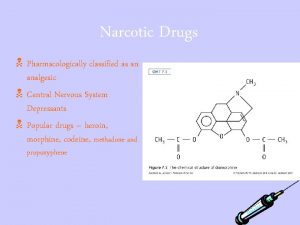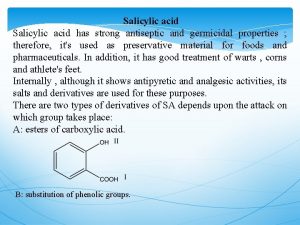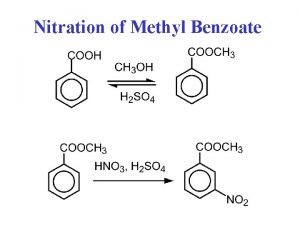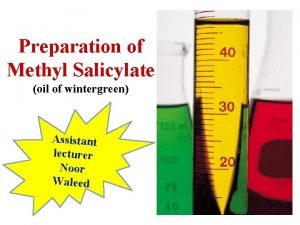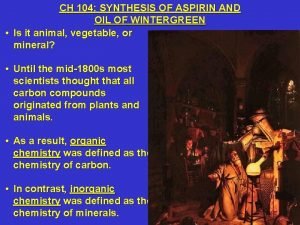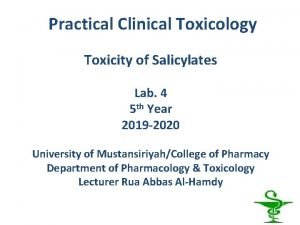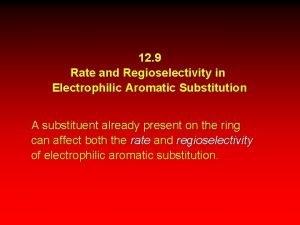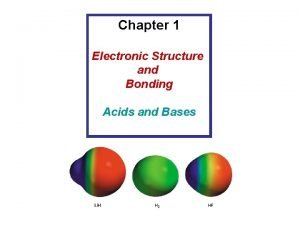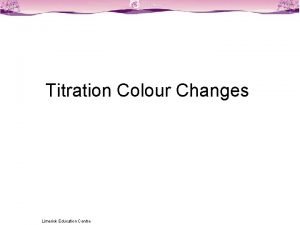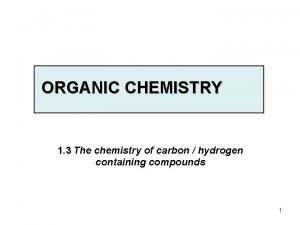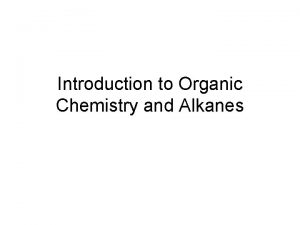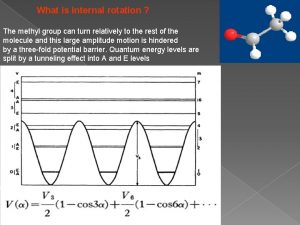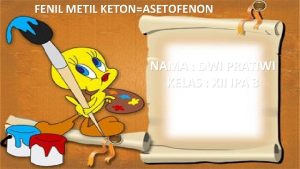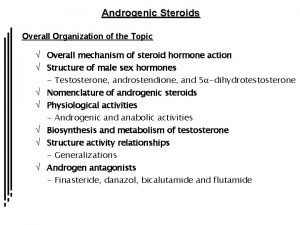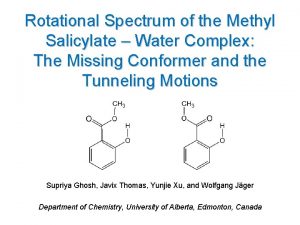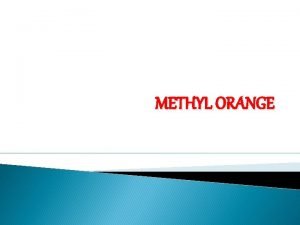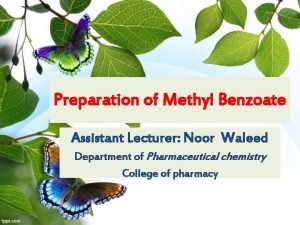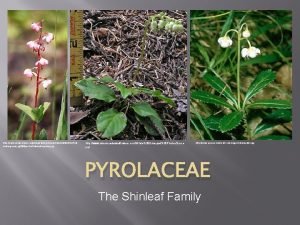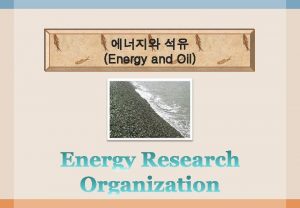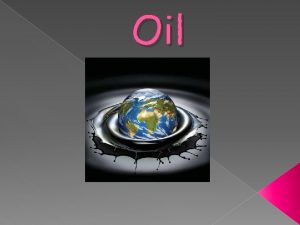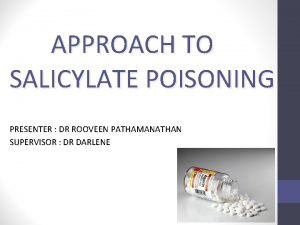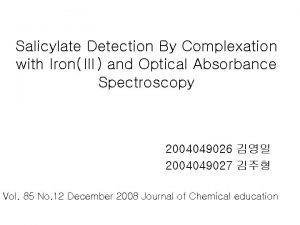Preparation of Methyl Salicylate oil of wintergreen Assistant




















- Slides: 20

Preparation of Methyl Salicylate (oil of wintergreen) Assistant lecturer Noor Waleed

• The second common ester of salicylic acid that is used as a drug is methyl salicylate. When salicylic acid is heated with methyl alcohol, the carboxyl group of salicylic acid is esterified producing a strong-smelling liquid ester (methyl salicylate).

• Fischer Esterification reaction : is the reaction of an alcohol and a carboxylic acid. The reaction is reversible and uses an acid as a catalyst. Methyl Salicylate M. wt. : 152. 15 gm/mol Molecular formula: C 8 H 8 O 3

• Uses: in high concentrations as a rubefacient and analgesic in deep heating liniments to treat joint and muscular pain. in low concentrations (0. 04% and under) as a flavoring agent in chewing gum and mints. providing fragrance to various products and as an odor-masking agent for some organophosphate pesticides to clear plant or animal tissue samples of color, and as such is useful for microscopy and immunohistochemistry when excess pigments obscure structures or block light in the tissue being examined. This clearing generally only takes a few minutes, but the tissue must first be dehydrated in alcohol. as a transfer agent, to produce a manual copy of an image on a surface. in small amounts, to lower the freezing point of glacial acetic acid for transport. a simulant for the research of chemical warfare agent sulfur mustard, due to its similar chemical and physical properties. an antiseptic in Listerine mouthwash. •

• In the chemistry laboratory, you took the advantage of the nucleophilicity of the phenolic OH on salicylic acid and the electrophilicity of acetic anhydride to form acetylsalicylic acid (aspirin).

• However, salicylic acid also has an electrophilic carbon atom as part of its carboxylic acid functional group. Thus, salicylic acid can react with nucleophilic molecules like methanol in addition to reacting with electrophilic molecules like acetic anhydride. The reaction of a carboxylic acid with an alcohol, an esterification, its analogues, amidation

• Esters often have interesting aromas associated with them. For example, many of the flavors that wines develop are formed when alcohols and carboxylic acids in the wine combine to form esters. The reaction that we will be doing is interesting for at least two reasons.

• Firstly, for the reaction to proceed at an appreciable rate, we must add an acid catalyst. Secondly, the reaction is an equilibrium reaction and particular effort must be made to drive the reaction to completion.

• By protonating the carbonyl (C=O), the carbonyl carbon becomes more electrophilic. Additionally, since the intermediate for the catalyzed reaction is not zwitterionic, as it is in the uncatalyzed reaction , the transition state that leads to the intermediate is lower in energy for the catalyzed reaction as compared to the uncatalyzed reaction.

• The acid catalyst also lowers the activation energy for the elimination of water from the intermediate. While the addition of the acid gets the reaction going, it cannot drive the equilibrium towards the products. Instead, this reaction will be driven to completion by the addition of excess methanol.

• Alternative methods for driving the reaction to completion include the removal of water from the reaction.

Chemicals Required: • 0. 65 g salicylic acid • 2. 0 m. L methanol • 0. 75 m. L concentrated sulfuric acid • 1 m. L CH 2 Cl 2 • 1 m. L 5% sodium bicarbonate solution.

Procedure 1. Place 0. 65 g of salicylic acid, 3. 0 m. L methanol and a magnetic stir bar in a conical flask. 2. Stir the mixture until the salicylic acid dissolves. 3. Place the conical flask on a stirring hotplate and while stirring slowly and in small portions add 0. 75 m. L of concentrated sulfuric acid to the salicylic acid: methanol solution. 4. Attach the conical flask to a water-cooled condenser, cap the condenser with a drying tube that has been loosely packed with Ca. Cl 2. 5. Gently boil the solution for 75 minutes (maintain the temperature at approximately 80 °C).

• The reflux will allow the mixture to heat without loss of components through evaporation. The vertical condenser returns the evaporated liquids to the boiling flask. • In this reaction, the reactants undergo a transesterification which is when an ester reacts with an alcohol to form a new ester.

Q 1/ Write the name of the reaction used to prepare methyl salicylate with the equation of our reaction? Q 2/ Explain why we use methyl salicylate in immunohistochemistry?

• Q 1/ Write the name of the reaction used to prepare methyl salicylate with the equation of our reaction? • Q 2/ Why we use H 2 SO 4 in it is preparation?

Q 1/ Why the salicylic acid act as a nucleophile once and as an electrophile in the other case explain ? Q 2/ Write 5 uses for the methylsalicylate?

Q 1/ Why we use methylsalicylate in organophosphate pesticides and in liniments? Q 2/ Write the general equation of ester preparation?

Q 1/ Write five uses for methyl salicylate? Q 2/ Why the salicylic acid act as a nucleophile once and as an electrophile in the other case explain with equation/s ?

Q 1/A/Aspirin/ Why we use H 2 SO 4 in synthesis of ASA ( method 1 ) with equation ? Q 1/B/ how could you recognize the decomposition of aspirin tablets Q 2/A/ methylsalicylate/ Why we use H 2 SO 4 in it is preparation? Q 2/B/ Write 5 uses for the methylsalicylate? Q 4/A/cannizzaro 2/ How could you remove any excess or unreacted benzaldehyde? Q 4/B / Why we use 10 % Na 2 CO 3 in separation of benzoic acid and benzyl alcohol with equation? Q 5/A/ benzoyleglycine/ Why we use sodium hydroxide in benzoyleglycine preparation? Q 5/B/ What we mean by benzoylation reaction? Give an equation as example?
 Methyl salicylate classification
Methyl salicylate classification Salicylic acid disinfectant
Salicylic acid disinfectant Salicyclate
Salicyclate Nitration of methyl benzoate product
Nitration of methyl benzoate product Fischer esterification methyl salicylate
Fischer esterification methyl salicylate Synthesis of oil of wintergreen
Synthesis of oil of wintergreen Julien froustey
Julien froustey Treatment of salicylate toxicity
Treatment of salicylate toxicity Dterra
Dterra How to prevent creaming in emulsion
How to prevent creaming in emulsion Methods of preparing emulsions
Methods of preparing emulsions Nitration of toluene ortho meta para
Nitration of toluene ortho meta para Ch3f lewis structure
Ch3f lewis structure Starch indicator
Starch indicator Methyl bromide banned countries list
Methyl bromide banned countries list Methyl ethyl propyl table
Methyl ethyl propyl table Methyl
Methyl Ethyl methyl propyl list
Ethyl methyl propyl list Methyl group
Methyl group Kegunaan asetofenon
Kegunaan asetofenon Steroids structure
Steroids structure
